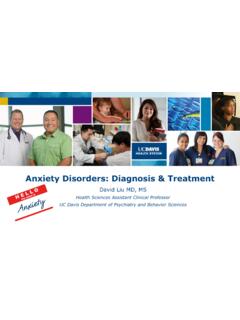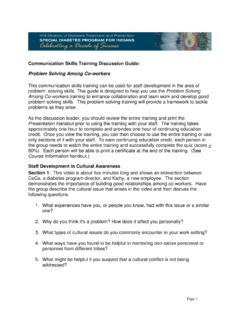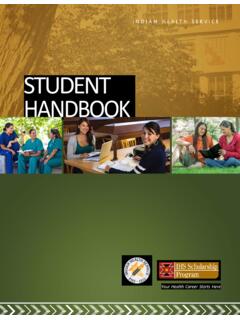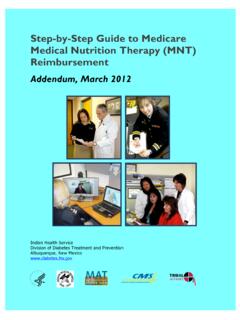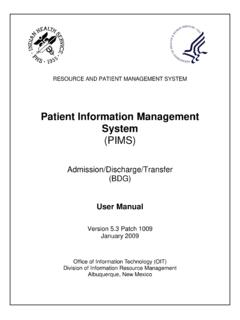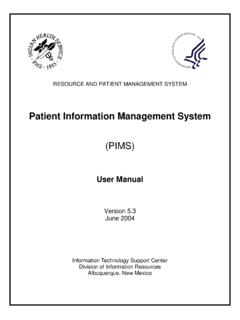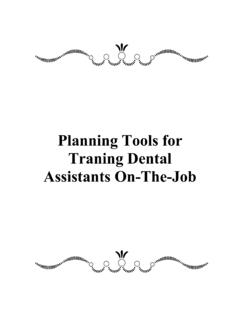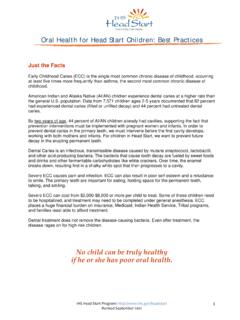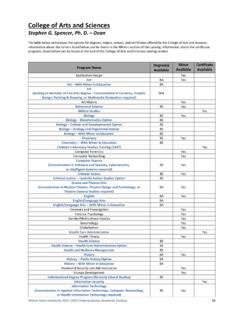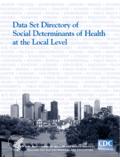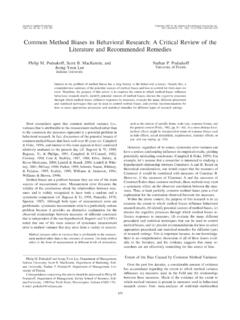Transcription of Suicide Assessment and Crisis Intervention in Children and ...
1 Suicide Assessment and Crisis Intervention in Children and AdolescentsMartha J. Molly Faulkner, phd, cnp, liseUniversity of new Mexico department of psychiatry and behavioral sciences , Division of Community behavioral HealthOctober 26, 2015 Objectives Listvulnerability factorsfor risk of Suicide using the Columbia Suicide SeverityRating Scale Recognize when a safety plan is indicated and how to help patient constructsafety plan Incorporate knowledge of Suicide screening and safety planninginto care inbehavioral health and medical following are warning signs of potentialsuicide or Suicide of appetite2. True or false:The term Suicide gesture is recommendedbecause it confounds lethality with intent3. The following statements are true:a)Any or all suicidal statements orbehaviors, regardless of how extreme,must be taken very seriouslyb)Never use the term successfulsuicide c)The Columbia Suicide Severity RatingScale must be conducted by those withmental health backgroundd)a & bAgenda Terminology Related to Suicide Epidemiology of Suicide in Children and Adolescents Assessment and Columbia Suicide Severity Rating Scale Safety Plan How to Incorporate into Health Care SettingTerminologyRelated to Suicide Suicidemeans killing oneself.
2 The act constitutes a person willingly, perhaps ambivalently, taking his or her ownlife. Several forms of suicidal behavior fall within the self-destructive spectrum. Completed suicidemeans the person has died. NEVER use term successful Suicide GOAL to prevent Suicide and provide treatment. Suicide attemptinvolves a serious act Taking fatal dose of medication, shooting self Someone intervening accidentally. Without the accidental discovery, the individual would be to Suicide Suicide gesturedenotes a person undertaking an unusual, but not fatal, behavior as a cry for help or to get attention. Suicide gambleis one in which patients gamble their lives that they will be found in time and that the discoverer will save them. For example, an individual ingests a fatal amount of drugs with the belief that family members will be home before death occurs. Suicide equivalentinvolves a situation in which the person does not attempt Suicide .
3 Instead, he or she uses behavior to get some of the reactions that Suicide would have caused. For example, an adolescent boy runs away from home, wanting to see how his parents respond. (Do they care? Are they sorry for the way that they have been treating him?) The action can be seen as an indirect cry for to Suicide Suicidality- All Suicide -related behaviors and thoughts Suicidal Ideation-Can be on continuum from passive to nonspecific ideation ( , I wish I had never been born ) to active specific ideation with intent and/or pan. Nonsuicidal self-injurious behavior (NSIB)- Any self-inflicted destructive act Performed without intent to die Full intent of inflicting physical harm to oneself (viewed as distinct from suicidal behavior) The term Suicide gesture is NOT recommended by the National Institute of Mental Health task force, nor is it included among the operational definitions because it confounds lethality with intent Parasuicidal Behavior- Suicidal gestures or self-harming behaviors in the context of suicidal ideation For the purpose of alerting others to their emotional pain Not typically behaviors which could have led to completed Suicide .
4 Suicide : 2011 OFFICIAL FINAL DATAN umberPer DayRate % of Deaths Nation .. 39,518 .. Males .. 31,003 .. Females .. 8,515 .. Whites .. 35,775 .. Nonwhites .. 3,743 .. Blacks .. 2,241 .. Elderly (65+ yrs.) .. 6,321 .. Young (15-24 yrs.) ..4,822 .. Middle Aged (45-64 yrs.) .. 15,379 .. : McIntosh, J. L., & Drapeau, C. W. (for the AmericanAssociation of Suicidology). (2014). Suicide 2011:Official final data. Washington, DC: American Association ofSuicidology, dated June 19, 2014, downloaded Suicide in Children and Adolescents 10thleading cause of death in the United States 3rdleading cause of death for Children , adolescents, and young adults Western states have highest Suicide rates, with the exception of Vermont. Rural areas carries a higher risk of Suicide than living in urban areas MacionisJJ. sociology Special Custom Edition for SNHU (selected by Prof J Walter). 9th ed. Upper Saddle River, NJ: Prentice-Hall.
5 2003 Epidemiologyof Suicide in Children and Adolescents 15 to 25% of adolescents endorse some degree of suicidal ideation 2-6% specific and active ideation 3rdleading cause of death among youth and young adults 13% of mortality in this age group in 2005 The Suicide rate in this age group increased by 8% from 2003 to 2004 (the largest single-year increase since 1990) Rate decreasedin last 10 yearsEpidemiology of Suicide in Children and adolescents Ratesof attempted and completed Suicide increase dramatically with age throughout childhood into adolescence due to: Elevated risk for psychopathology incurred during adolescenceIncreased capacity to prepare and executea Suicide plan with cognitive maturityDecreased supervision with age Prepubertalchildren do endorse suicidal ideation but:Cognitive immaturity appears to limit ability to plan and execute lethal Suicide attemptsPreschool Children :Suicidal behavior is rare When present in this age group, physical and/or sexual abuse is commonEPIDEMIOLOGY of Suicide in Children and Adolescents Females10% vs 4% more likely to attempt Suicide and have specific ideation Males6:1 more likely to complete Suicide use more lethal means such as hanging or firearms substance use and antisocial behaviors Adoptees4 x more likely to attempt Suicide than those not adopted (Keyes, Malone, Sharma, Iacono, McGue, 2013) Children with parent who has attempted Suicide almost 5x risk of attempting Suicide (Brent, et al.)
6 2015)Ethnicity andSuicide in Children and Adolescents Suicide is prevalent inall ethnic groups Higher among non white American Indian highest rate Completed Suicide in young African American males growing Hispanic higher rates and attempts Little known about Asian American youth who do not disclose suicidal ideation and underutilize mental health services LOWER SES except for African American males as completed Suicide associated with higher SESWhy do they Suicide ?Precipitating Circumstances of Suicide Among Youth Aged 10 17 Years by Sex: Data From the National Violent Death Reporting system 16 States 2005-2008 Most Common Relationship problems Recent crises Mental health problems Intimate partner violence School problems 25% of drop in bullying related Died in a house or an apartment ( ). Most Common co-morbid Psychiatric Disorders in Children and Adolescents who Attempt Suicide Substance Abuse (27-62%) Conduct/Disruptive Behavior Borderline or Antisocial Personality Post Traumatic Stress (PTSD) Chronic Medical Illnesses 90% of individuals who commit Suicide have untreated mental illness---60%depression 50-75% of Children with depression go undiagnosed and untreated < 20% of adolescent suicides receive any consistent treatment prior to (61-76%)Populations Most vulnerable to suicideHigher risk for Suicide or Suicide attempts than the general population.
7 American Indians and Alaska Natives People bereaved by Suicide People in justice and child welfare settings People who intentionally hurt themselves (non-suicidal self-injury) People who have previously attempted Suicide People with medical conditions People with mental and/or substance use disorders People who are lesbian, gay, bisexual, or transgender Members of the military and veterans Men in midlife and older menTake home message Any or all suicidal statements or behaviors, regardless of how extreme, must be taken very seriously!Take Home Message ALLof our patients need to be screened for suicidality, even if we do not expect it in the leastHow to Identify Suicidal Children and Adolescents?Why Assess Suicide Risk? Increasesawareness Provides a common language about Suicide Provides guidancefor developing an action plan Helps to ensure that all staff are following a standardized, evidence based protocol toidentify individuals at risk of suicideWhy Assess Suicide Risk?
8 Evidence exists that screening actually DECREASES referrals to behavioral health Provides behavioral health resources to those who truly need them, not to those who weren t actually at high risk May actually save livesAlicia 15 yrAA/Hispfemale. Father in service for years. High achiever, straight A s, attends parochial school. Likes to be unique but inwardly low self esteem. Met older teen at driver s edin the summertime and began hanging out with him and his friends. Just prior to breakup began cutting on wrist. After breakup attempted Suicide by Suicidal Patients Be attentive Remain calm and do not appear threatened Stress a partnership approach Discuss Suicide in a calm, reasoned manner Listen to the patient Emphasize that Suicide causes a great deal of pain to family members Warning signs or signs of vulnerability to Suicide History of Impulsive Aggression Prior Suicide Attempts Hopelessness/Helplessness No Future Orientation Exposure to Recent Suicide Psychiatric Disorders Comorbid psychiatric disorders ( , disruptive disorders, substance abuse) Availability of lethal, agents ( , firearms), exposure to negative events ( , physical or sexual abuse, violence Family history of suicidal behavior Suicide Assessment .)
9 Warning Signs Pacing Agitated behavior Frequent mood changes Chronic episodes of sleeplessness Actions or threats of assault, physical harm or violence Delusions or hallucinations Past Suicide attempt Recent loss Threats or talk of death ( , "I don't care anymore," or "You won't have to worry about me much longer.") Putting affairs in order, such as giving possessions away Unusually risky behavior ( , unsafe driving, abuse of alcohol or other drugs)Columbia Suicide Severity Rating Scale (CSSRS)A semi-structured interview used to assess Suicide riskThe questionscontained in the Columbia- Suicide Severity Rating Scale are suggested probes. Ultimately, the determination of the presence of suicidal ideation or behavior depends on the judgment of the individual administering the scale. Center for Suicide Risk AssessmentVideoWhy use the Columbia Suicide severity rating scale? (CSSRS) Don t need mental health training Comes in multiple formats Screener version appropriate for First Responders, gatekeepers, peer counselors Full version appropriate for behavioral health clinicians Versions for Children , intellectually disabled Available in 100+ languages Versions to assess lifetime/recent/since last visit Used for research, and clinically Flexible format, don t need to ask all the questionsif not necessary Integrate information given by collateral sources family, caregiversVersions of Columbia Suicide Severity Rating Scale TheLifetime/Recentversion Practitioners gather lifetime history of suicidality any recent suicidal ideation and/or behavior.
10 For behavior it is used to capture all lifetime occurrences, For ideation (which is hard to average throughout a lifetime) the reference point used is the time the person felt most suicidal. which has been shown to be the most predictive of completed Suicide in the future (Beck, , et al.,1999).TheSince Last Visitversion Assesses suicidality since the patient s last visit. Meant to assess patients who have completed at least one Lifetime/Recent C-SSRS Assessment . Asks about any suicidal thoughts or behaviorsthe patient/participant may have had since the last time you have administered the of Columbia Suicide Severity Rating Scale TheScreenerversion Shortened form of the Full Version. 3-6 questions long. Commonly used for clinical triage by first responders, in ER settings and Crisis call centers, for non-mental health users like teachers or clergy or in situations where frequent monitoring is required( inpatient shift monitoring, day programs).
